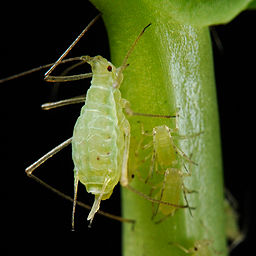Mycorrhizal fungi live in the soil and are able to form friendly relationships (symbioses) with the majority of land plants. In return for sugars from the plant the mycorrhizal fungi provide nutrients including phosphate and nitrogen. The fungi have broad plant host ranges so an individual fungus can establish symbioses with several plants. Plants can maintain symbioses with several mycorrhizial fungi so the result is a whole series of connections between plants and fungi in the soil known as “common mycelial networks”.
Evidence is emerging that these mycelial networks can be involved in plant defence against microbes and insects. Healthy tomato plants connected via mycelial networks to diseased plants have increased disease resistance and increased expression of defence-related genes (1).
In a recent paper in the journal Ecology Letters, Babikova and colleagues (2) studied the role of mycelial networks in broad been (Vicia faba) defence against aphids. Aphids are sap-sucking insects and colonisation of plants leads to a number of symptoms including decreased growth rates and lower yields. The aphids can also be carriers of disease-causing agents such as viruses, which are transmitted via the insect saliva.
Healthy uninfected plants release volatile compounds from their leaves, which the aphids can detect and are attracted to. However, once infected the composition of volatile compounds can change, becoming repellent to the aphids and attractive to the aphids natural predators such as parasitoid wasps. Bakikova and colleagues used the behaviour of pea aphids (Acyrthosiphon pisum Harris) and parasitoid wasp (Aphidius ervi Haliday) as a means of measuring plant defence status.
Plants were grown in closed environments called mesocosms. Within each mesocosm a “donor” plant was placed, to be infected with aphids towards the end of the experiment. Surrounding the donor were the receiver plants; one was allowed to form root and mycorrhizal contact with the donor, another could form mycorrhizal contact only and two controls that had neither root or mycorrhizal contact. After a few weeks in the mesocosms when the mycorrhizal network was established the plants were all placed in bags to prevent any exchange of signals between the plants above ground, and the donor plant was infected with aphids. Four days after this the volatiles contained within the plant bags were collected.
The group found that when aphids and parasitoid wasps were exposed to air samples from the plant bags there were differences in the behaviour of the insects (view the research paper for details of the method used of measuring this ref 2). The infected donor plant air samples were much more attractive to the parastoid wasp than the aphids as you would expect (plant defences turned on). The control plants with no mycorrhizal or root contact had not been exposed to the aphids and the air samples from them were much more attractive to the aphids than the parasitoid wasps. However, the air samples from plants with mycorrhizal and/or root contact were more attractive to the parasitoid wasps than the aphids, showing that they had activated defence responses to the aphids despite not being infected themselves. There was no difference between plants with mycorrhizal contact only and those with root and mycorrhizal contact to the donor plant suggesting that the mycorrhizal network was the primary way that defence signals were being transmitted.
Further analysis of the volatile compounds contained within the plant bags found that methyl salicylate was the main driver of aphid behaviour. The addition of methyl salicylate to air samples previously attractive to aphids made the samples repellent to aphids. Methyl salicylate has previously been shown to repel other aphid species and attract parasitoids and it is also thought that it can be transported around the plant in the phloem to induce defence responses.
I really like this paper because in the experimental design authors have been able to allow the plants to form mycorrhizal connections but prevent other methods of signal transmission such as root contact or release of volatile compounds into the air from the leaves. It demonstrates that mycelial networks may play an important role in plant defence against aphids by enabling the transfer of signals from infected plants to uninfected plants to prime their defences against the insects. The identity of the signal molecule is still a mystery.

When aphids infect the plant on the left a signal travels to through the mycorrhizal network warning other (uninfected) plants that aphids are nearby. This induces defence responses that include the production of methyl salicylate, which repels the aphids and attracts the parasitoid wasp (an aphid predator).
Mycelial network connections to neighbours can have downsides too. Chemicals produced by marigold can be transported through mycelial networks to inhibit the growth of neighbouring plants (3). Also, carbon compounds can be “stolen” from the mycelial network by many parasitic plants that don’t produce carbon by photosynthesis themselves (4). Despite this, most of the time the downsides of mycelial networks must be outweighed by the nutrient benefit to the plants and the assistance with defence against pests and disease-causing microbes.
References:
1. Song et al (2010) Interplant commonucation of tomato plants through underground common mycorrhizal networks. PLoS One
2. Babikova et al (2013) Underground signals carried through common mycelial netowrks warn neighbouring plants of aphid attack. Ecology Letters.
3. Barto et al. (2011) The fungal fast lane: common mycorrhizal networks extend bioactive zones of allelchemicals in soils. PLoS One.
4. Bidartondo (2002) Epiparasitic plants specialized on arbuscular mycorrhizal fungi. Nature

Pingback: Guest post. Fungi: more than just mushrooms | Plant Scientist
Pingback: Morsels for the mind – 28/6/2013 › Six Incredible Things Before Breakfast
Pingback: Find about more about fungi for UK Fungus day | Plant Scientist
Pingback: La comunicación de las plantas a través de los hongos del suelo. | Disiciencia